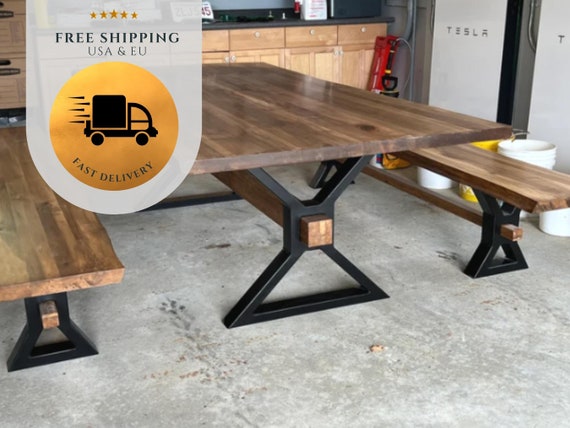Dining Room Table Legs: What to Think about Before You Purchase
Dining Room Table Legs: What to Think about Before You Purchase
Blog Article
A Comprehensive Consider Table Leg Styles: Locating the Ideal Match
Selecting the ideal table leg style is essential for both aesthetic charm and functional functionality. Traditional 4 legs offer timeless sophistication and stability, while the stand base provides increased legroom and a contemporary look. For those with larger tables, trestle legs ensure durable support, whereas barrette legs introduce a mid-century contemporary vibe with their minimalist layout. The x-shaped legs blend contemporary style with enhanced stability. Each of these alternatives brings distinct benefits, making the selection more than simply a matter of choice. Discover even more to find which design flawlessly matches your dining room and way of living.
Standard Four Legs
Among the different kinds of dining table leg designs, the traditional four-leg layout stays a classic choice for many families. Four legs provide well balanced assistance, making certain the table stays steady and capable of birthing substantial weight (dining room table legs).
From an aesthetic perspective, the typical four-leg style can be conveniently adapted to different indoor styles. Whether crafted from timber, steel, or a mix of products, these legs can be delicately sculpted, sleek and minimalistic, or anything in between. Their flexibility allows them to match both rustic and modern setups seamlessly.
Furthermore, the simple framework of the four-leg design facilitates convenience of movement and positioning within a space. Unlike even more facility bases, this style decreases obstructions, supplying adequate legroom for restaurants. In summary, the standard four-leg dining table leg style weds sustaining style with sensible capability, making it a sharp choice for those seeking both type and feature in their eating furnishings.
Stand Base
Usually celebrated for its elegant and space-efficient layout, the pedestal base is a prominent alternative to the standard four-leg configuration in table leg designs. This distinct base generally includes a single main column sustaining the table top, which can differ in form, from ornately sculpted wood to streamlined, contemporary steel. Among the main benefits of the pedestal base is its capacity to make best use of legroom and seating adaptability. Without edge legs, diners are paid for greater freedom of movement, making it an optimal option for round and oblong tables that promote even more intimate and inclusive events.
Moreover, the stand base's central support can manage considerable weight, enabling the usage of much heavier table tops, such as marble or thick hardwood. This strength paired with its aesthetic versatility makes the pedestal base a prominent option in both conventional and contemporary indoor settings. It can effortlessly integrate with various layout themes, from traditional style to minimal modernity. The main column itself provides a canvas for intricate layouts and imaginative expressions, adding an element of aesthetic passion under the table. In summary, the stand base incorporates capability snappy, making it a refined and practical alternative for varied eating environments.
Trestle Legs
Trestle legs offer a robust and ageless foundation for dining tables, identified by their straight cross-bracing and strong assistance beams. Originating from middle ages times, this style has advanced yet retained its essential structure, making it a perennial fave in both standard and modern settings. The central trestle beam, often supported by two or even more upright messages, supplies exceptional stability, enabling bigger table lengths without the demand for extra legs.
A significant advantage of trestle leg tables is the ample legroom they offer. Unlike tables with 4 corner legs, the absence of blockages at the table's edges offers unimpeded area for chairs and restaurants, enhancing convenience and accessibility. This makes trestle tables ideal for suiting larger events, whether in an eating space or a reception hall.
The visual convenience of trestle legs is notable. Readily available in a selection of materials such as timber, steel, and composite, they can be completed to match a variety of interior styles. From rustic farmhouse to streamlined modern styles, trestle legs can be customized click to fit individual tastes. Their enduring appeal and useful benefits make trestle legs an engaging option for those looking for both style and practicality in their table.
Barrette Legs

The appeal of hairpin legs hinges on their simplicity and adaptability - dining room table legs. Available in a variety of materials, consisting of steel and brass, they can be finished in numerous shades to match various indoor designs. Whether paired with a rustic wood table top or a modern glass surface, hairpin legs effortlessly mix functionality with a touch of vintage beauty
Resilience is one more notable feature of hairpin legs. In anchor spite of their delicate appearance, these legs are engineered to bear significant weight, making certain the table continues to be secure and secure. Additionally, they are relatively simple to mount, making them a popular option for do it yourself enthusiasts and expert furnishings makers alike.
X-Shaped Legs

Built from materials such as steel, wood, or a combination of both, X-shaped legs can be customized to match various layout preferences. Steel legs usually offer a sleek and commercial feel, ideal for loft-style apartment or condos and modern-day eating spaces. On the other hand, wood X-shaped legs use a warmer, a lot more rustic allure, suitable for farmhouse or eclectic interiors. The versatility in materials permits house owners to personalize their table to much better fit their general layout scheme.
In addition, the engineering behind X-shaped legs find more info makes sure even weight circulation, lessening the risk of wobbling and enhancing longevity. This makes them especially well-suited for bigger table that require added assistance. Essentially, X-shaped legs mix useful design with modern-day aesthetic appeals, making them an ageless selection for varied dining atmospheres.
Conclusion
A comprehensive understanding of eating table leg designs reveals the unique features and advantages of each layout. Trestle legs make certain durable support for bigger tables, and barrette legs introduce a mid-century contemporary visual.
Report this page